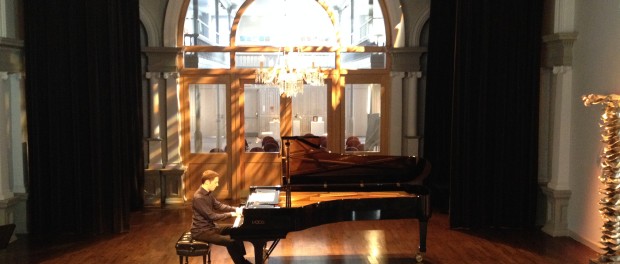David Jalbert Rocks Bach
Johann Sebastian Bach wrote the Goldberg Variations in 1741 for one of his contemporaries — the harpsichordist Johann Gottlieb Goldberg — to play in the middle of the night when the Count for whom he worked had trouble sleeping. Consisting of an aria (a simple song-like melody) and 30 variations, which together form a compendium of every style of composition popular in the mid-18th century, the Goldberg Variations pose an unusual number of challenges to the modern-day pianist.
http://www.youtube.com/watch?v=2ZYjGz_NbwM”>
First of all, the piece was written for a 2-manual keyboard; to play it on a single keyboard such as a piano presents some challenges, primarily of the hand-crossing variety. Second, the work, when played with all the repeats as indicated by Bach, lasts a good 75 minutes. Third, the Goldberg Variations require a tremendous technical ability and control, as well as a profound understanding of the baroque style, which called for a certain amount of improvisation (notably in the ornamentation). This work is not for the pianistic faint of heart.
Many great pianists have recorded and performed the Variations, but perhaps the best-known recordings are those undertaken by the great and eccentric Canadian pianist Glenn Gould, who tackled the work not once, but twice — first in 1955, then again just before he died in 1981. With his idiosyncratic interpretations, his characteristic “singing” (aka grunting) along in the background, and the mysterious differences between the two recordings (aficionados spend hours discussing the potential connections between his approaching death and the more contemplative tempo in the aria in the second recording), it’s hard to believe that any contemporary pianist would dare to tread on this sacred ground.
But Quebec pianist David Jalbert (currently based in Ottawa) is nothing if not intrepid! He first performed the Goldberg Variations at Montreal’s Chamber Music Festival in 2011, and released a critically acclaimed recording in 2012. He was back in Montréal on Sunday February 23 to perform the work at the intimate and lovely Chapelle Historique du Bon-Pasteur. Completely at ease in front of the more-than-sold-out crowd, Jalbert provided an extremely informative and entertaining pre-concert lecture to help the audience better follow the performance.
http://www.youtube.com/watch?v=teat-yBHjvU
And what a performance it was—with flawless technique, judicious use of both soft and damper pedals, and perfect execution of those finicky baroque ornaments, Jalbert captured the extraordinary variety inherent in Bach’s masterpiece. From the sparkle of the 5th variation to the elegance of the 7th, from the beautiful voicing of the 13th to the crazy virtuosity of the 20th and the shimmering trills of the 29th, Jalbert demonstrated not only his technical mastery, but a profound musical insight and imagination. By the 19th variation it felt like we had entered a parallel universe where Bach is God and Jalbert his messenger.
For me the highlight of the performance was the 25th variation, which Jalbert called the “black pearl” of the work. One of only three variations in the minor mode, one can only wonder if Bach wrote it to give the Count strange and wondrous nightmares. With harmony as funky as Chopin’s, and long and winding melodies that lead the ear down dark and twisted paths, this variation seems somewhat anomalous, although its beauty is unquestionably haunting. If I have one complaint, it’s that Jalbert did not leave enough time between this variation and the next. But perhaps he didn’t want us dwelling on our own personal black pearls….
The audience gave Jalbert an immediate and well-deserved standing ovation. Montreal eagerly awaits his return!








